Black Screen
DESCRIPTION
The video signal from the television camera assembly is transmitted to the radio and display receiver assembly.
WIRING DIAGRAM
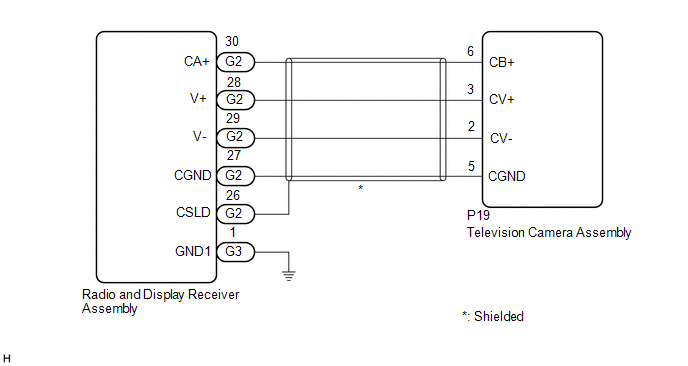
CAUTION / NOTICE / HINT
NOTICE:
Depending
on the parts that are replaced or operations that are performed during
vehicle inspection or maintenance, calibration of other systems as well
as the parking assist monitor system may be needed.
Click here

PROCEDURE
| 1. |
CHECK HARNESS AND CONNECTOR (RADIO AND DISPLAY RECEIVER ASSEMBLY - TELEVISION CAMERA ASSEMBLY) |
Click here 
| NG |
 | REPAIR OR REPLACE HARNESS OR CONNECTOR |
|
OK |
 | |
| 2. |
INSPECT RADIO AND DISPLAY RECEIVER ASSEMBLY |
Click here 
| NG |
 | REPLACE RADIO AND DISPLAY RECEIVER ASSEMBLY |
|
OK |
 | |
| 3. |
INSPECT RADIO AND DISPLAY RECEIVER ASSEMBLY (V+, GND1) |
Click here 
| NG |
 | REPLACE TELEVISION CAMERA ASSEMBLY |
|
OK |
 | |
| 4. |
REPLACE RADIO AND DISPLAY RECEIVER ASSEMBLY |
(a) Replace the radio and display receiver assembly with a new or known good one.
Click here 
(b) Check that the parking assist monitor system operates normally.
OK:
Parking assist monitor system operates normally.
| OK |
 | END |
| NG |
 | REPLACE TELEVISION CAMERA ASSEMBLY |
Vehicle Information Unmatched (C168D)
DESCRIPTION
This DTC is
stored if the television camera assembly judges as a result of its self
check that the vehicle information received from the main body ECU
(multiplex network body ECU) via CAN communication and the vehicle
information stored in the television camera assembly do not match.
|
DTC No. | Detection Item |
DTC Detection Condition | Trouble Area |
|
C168D | Vehicle Information Unmatched |
Vehicle information is unmatched |
- Television camera assembly optical axis adjustment (back camera position setting)
- Steering angle setting
- Television camera assembly
|
CAUTION / NOTICE / HINT
NOTICE:
Depending
on the parts that are replaced or operations that are performed during
vehicle inspection or maintenance, calibration of other systems as well
as the parking assist monitor system may be needed.
Click here

PROCEDURE
(a)
Perform the following procedure depending on the memory conditions to
register the vehicle information into the television camera assembly.
(1) Television camera assembly optical axis adjustment (back camera position setting).
Click here 
(2) Steering angle setting.
Click here 
|
NEXT |
 | |
(a) Clear the DTCs.
Chassis > Parking Assist Camera > Clear DTCs
(b) Recheck for DTCs and check that no DTCs are output.
Chassis > Parking Assist Camera > Trouble Codes
HINT:
- If DTC C168D is output, perform the procedure to register the vehicle information into the television camera assembly.
- If DTC C168D is still output after performing the procedure to register
the vehicle information into the television camera assembly 3 times,
replace the television camera assembly.
|
Result | Proceed to |
|
DTC C168D is output | A |
|
DTC C168D is not output |
B |
| A |
 | REPLACE TELEVISION CAMERA ASSEMBLY |
| B |
 | END |
ECU Malfunction (C1611)
DESCRIPTION
This DTC is stored if the television camera assembly judges that there is an internal malfunction as a result of its self check.
HINT:
The
television camera assembly stores different types of information during
initialization. If the television camera assembly cannot read the
stored information when it is activated, the television camera assembly
judges that there is an internal malfunction and stores this DTC.
|
DTC No. | Detection Item |
DTC Detection Condition | Trouble Area |
|
C1611 | ECU Malfunction |
When one of the following conditions is met:
- EEPROM status (Initial read) malfunction
- CPU communication malfunction
- Video output malfunction
| Television camera assembly |
CAUTION / NOTICE / HINT
NOTICE:
Depending
on the parts that are replaced or operations that are performed during
vehicle inspection or maintenance, calibration of other systems as well
as the parking assist monitor system may be needed.
Click here

PROCEDURE
| 1. |
READ VALUE USING TECHSTREAM |
(a) Connect the Techstream to the DLC3.
(b) Turn the engine switch on (IG).
(c) Turn the Techstream on.
(d) Enter the following menus: Chassis / Parking Assist Camera / Data List.
(e) According to the display on the Techstream, read the Data List.
Chassis > Parking Assist Camera > Data List
|
Tester Display | Measurement Item |
Range | Normal Condition |
Diagnostic Note |
|
Video Output Status | Output condition of video signal |
OK or NG | OK: Output condition of video signal is normal
NG: Output condition of video signal is abnormal |
- |
| EEPROM Status (Initial read) |
Television camera assembly information |
OK or NG | OK: Television camera assembly normal
NG: Television camera assembly abnormal |
- |
| CPU Communication Status |
Television camera assembly information |
OK or NG | OK: Television camera assembly normal
NG: Television camera assembly abnormal |
- |
Chassis > Parking Assist Camera > Data List
|
Tester Display |
| Video Output Status |
|
EEPROM Status (Initial read) |
|
CPU Communication Status |
|
Result | Proceed to |
|
OK is displayed for all items |
A |
| NG is displayed for EEPROM status (Initial read) |
|
NG is displayed for items other than EEPROM status (Initial read) |
B |
| B |
 | REPLACE TELEVISION CAMERA ASSEMBLY |
|
A |
 | |
(a)
Perform the following procedure depending on the memory conditions to
register the vehicle information into the television camera assembly.
(1) Television camera assembly optical axis adjustment (back camera position setting).
Click here 
(2) Steering angle setting.
Click here 
|
NEXT |
 | |
(a) Clear the DTCs.
Chassis > Parking Assist Camera > Clear DTCs
(b) Recheck for DTCs and check that no DTCs are output.
Chassis > Parking Assist Camera > Trouble Codes
HINT:
- If DTC C1611 is output, perform the procedure to allow the television camera assembly to store the vehicle information again.
- If DTC C1611 is still output after performing the procedure to make the
television camera assembly store the vehicle information 3 times,
replace the television camera assembly.
|
Result | Proceed to |
|
DTC C1611 is output | A |
|
DTC C1611 is not output |
B |
| A |
 | REPLACE TELEVISION CAMERA ASSEMBLY |
| B |
 | END |
Back Camera Power Supply Failure (C1621)
DESCRIPTION
This DTC is
stored if the television camera assembly judges as a result of its self
check that the signals or signal lines between the television camera
assembly and radio and display assembly are not normal.
|
DTC No. | Detection Item |
DTC Detection Condition | Trouble Area |
|
C1621 | Back Camera Power Supply Failure |
Television camera assembly power supply failure |
- Harness or connector
- Television camera assembly
- Radio and display receiver assembly
|
WIRING DIAGRAM
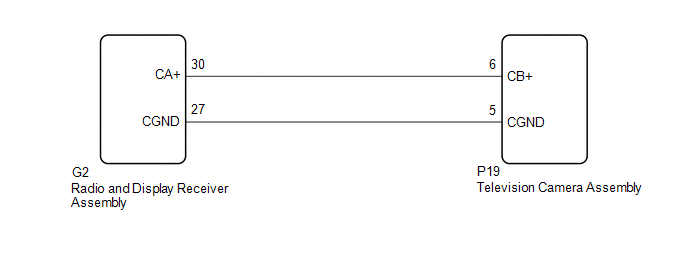
CAUTION / NOTICE / HINT
NOTICE:
Depending
on the parts that are replaced or operations that are performed during
vehicle inspection or maintenance, calibration of other systems as well
as the parking assist monitor system may be needed.
Click here

PROCEDURE
| 1. |
CHECK HARNESS AND CONNECTOR (RADIO AND DISPLAY RECEIVER ASSEMBLY - TELEVISION CAMERA ASSEMBLY) |
(a) Disconnect the G2 radio and display receiver assembly connector.
(b) Disconnect the P19 television camera assembly connector.
(c) Measure the resistance according to the value(s) in the table below.
Standard Resistance:
|
Tester Connection | Condition |
Specified Condition |
|
G2-30 (CA+) - P19-6 (CB+) |
Always | Below 1 Ω |
|
G2-27 (CGND) - P19-5 (CGND) |
Always | Below 1 Ω |
|
G2-30 (CA+) or P19-6 (CB+) - Body ground |
Always | 10 kΩ or higher |
|
G2-27 (CGND) or P19-5 (CGND) - Body ground |
Always | 10 kΩ or higher |
| NG |
 | REPAIR OR REPLACE HARNESS OR CONNECTOR |
|
OK |
 | |
| 2. |
INSPECT RADIO AND DISPLAY RECEIVER ASSEMBLY |
(a) Reconnect the G2 radio and display receiver assembly connector.
| (b) Measure the resistance according to the value(s) in the table below.
Standard Resistance: |
Tester Connection | Condition |
Specified Condition | |
G2-27 (CGND) - Body ground |
Always | Below 1 Ω | |
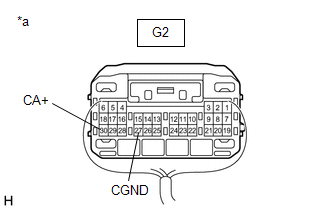 |
|
*a | Component with harness connected
(Radio and Display Receiver Assembly) | | |
(c) Measure the voltage according to the value(s) in the table below.
Standard Voltage:
|
Tester Connection | Condition |
Specified Condition |
|
G2-30 (CA+) - G2-27 (CGND) |
Engine switch on (ACC) |
5.5 to 7.05 V |
| OK |
 | REPLACE TELEVISION CAMERA ASSEMBLY |
| NG |
 | REPLACE RADIO AND DISPLAY RECEIVER ASSEMBLY |
Back Camera Disconnected (C1622)
DESCRIPTION
This DTC is
stored if the radio and display receiver assembly judges that the
signals or signal lines between the television camera assembly, and the
radio and display receiver assembly are not normal as a result of its
self check.
|
DTC No. | Detection Item |
DTC Detection Condition | Trouble Area |
|
C1622 | Back Camera Disconnected |
Open or short in the television camera assembly signal circuit |
- Harness or connector
- Television camera assembly
- Radio and display receiver assembly
|
WIRING DIAGRAM
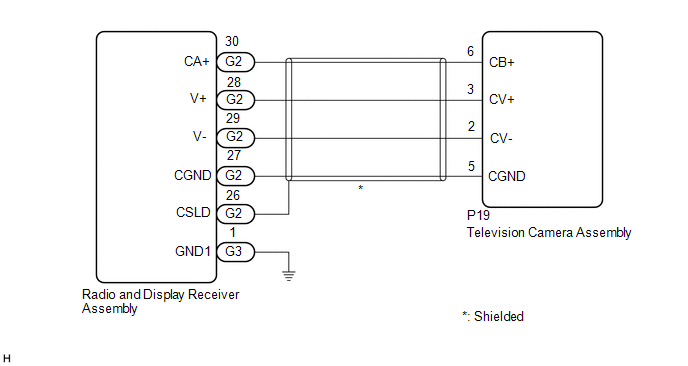
CAUTION / NOTICE / HINT
NOTICE:
Depending
on the parts that are replaced or operations that are performed during
vehicle inspection or maintenance, calibration of other systems as well
as the parking assist monitor system may be needed.
Click here

PROCEDURE
| 1. |
CHECK HARNESS AND CONNECTOR (RADIO AND DISPLAY RECEIVER ASSEMBLY - TELEVISION CAMERA ASSEMBLY) |
(a) Disconnect the G2 radio and display receiver assembly connector.
(b) Disconnect the P19 television camera assembly connector.
(c) Measure the resistance according to the value(s) in the table below.
Standard Resistance:
|
Tester Connection | Condition |
Specified Condition |
|
G2-30 (CA+) - P19-6 (CB+) |
Always | Below 1 Ω |
|
G2-28 (V+) - P19-3 (CV+) |
Always | Below 1 Ω |
|
G2-29 (V-) - P19-2 (CV-) |
Always | Below 1 Ω |
|
G2-27 (CGND) - P19-5 (CGND) |
Always | Below 1 Ω |
|
G2-26 (CSLD) - Body ground |
Always | 10 kΩ or higher |
|
G2-30 (CA+) or P19-6 (CB+) - Body ground |
Always | 10 kΩ or higher |
|
G2-28 (V+) or P19-3 (CV+) - Body ground |
Always | 10 kΩ or higher |
|
G2-29 (V-) or P19-2 (CV-) - Body ground |
Always | 10 kΩ or higher |
|
G2-27 (CGND) or P19-5 (CGND) - Body ground |
Always | 10 kΩ or higher |
| NG |
 | REPAIR OR REPLACE HARNESS OR CONNECTOR |
|
OK |
 | |
| 2. |
INSPECT RADIO AND DISPLAY RECEIVER ASSEMBLY |
(a) Reconnect the G2 radio and display receiver assembly connector.
| (b) Measure the resistance according to the value(s) in the table below.
Standard Resistance: |
Tester Connection | Condition |
Specified Condition | |
G2-29 (V-) - Body ground |
Always | Below 1 Ω | |
G2-27 (CGND) - Body ground |
Always | Below 1 Ω | |
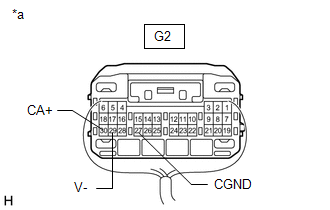 |
|
*a | Component with harness connected
(Radio and Display Receiver Assembly) | | |
(c) Measure the voltage according to the value(s) in the table below.
Standard Voltage:
|
Tester Connection | Condition |
Specified Condition |
|
G2-30 (CA+) - G2-27 (CGND) |
Engine switch on (ACC) |
5.5 to 7.05 V |
| NG |
 | REPLACE RADIO AND DISPLAY RECEIVER ASSEMBLY |
|
OK |
 | |
| 3. |
INSPECT RADIO AND DISPLAY RECEIVER ASSEMBLY (V+, GND1) |
(a) Reconnect the P19 television camera assembly connector.
(b) Using an oscilloscope, check the waveform of the television camera assembly.
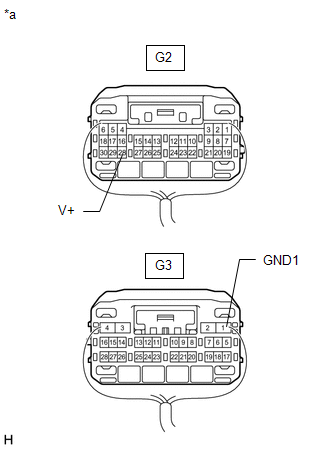
|
*a | Component with harness connected
(Radio and Display Receiver Assembly) |
HINT:
A
waterproof connector is used for the television camera assembly.
Therefore, inspect the waveform at the radio and display receiver
assembly with the connector connected.
OK:
Waveform is similar to that shown in the illustration.
|
Item | Content |
|
Measurement terminal |
G2-28 (V+) - G3-1 (GND1) |
|
Measurement setting | 200 mV/DIV., 50 ÎĽs./DIV. |
|
Condition | Engine switch on (IG), shift lever in R |
HINT:
- The video waveform changes according to the image sent by the television camera assembly.
- The video waveform is constantly output when the engine switch is on (ACC).
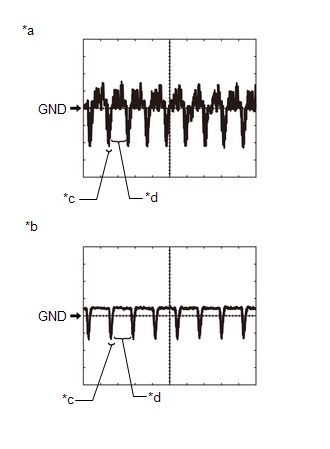
|
*a | Waveform 1 (camera lens is not covered, displaying an image) |
|
*b | Waveform 2 (camera lens is covered, blacking out the screen) |
|
*c | Synchronization Signal |
|
*d | Video Waveform |
| OK |
 | REPLACE RADIO AND DISPLAY RECEIVER ASSEMBLY |
| NG |
 | REPLACE TELEVISION CAMERA ASSEMBLY |
Open or Short in Steering Angle Sensor +B (C1625)
DESCRIPTION
This DTC is
stored if the television camera assembly receives a signal via CAN
communication from the steering sensor that indicates a power supply
problem.
|
DTC No. | Detection Item |
DTC Detection Condition | Trouble Area |
|
C1625 | Open or Short in Steering Angle Sensor +B |
Open or short in steering sensor power source |
- Harness or connector
- Steering sensor
|
WIRING DIAGRAM
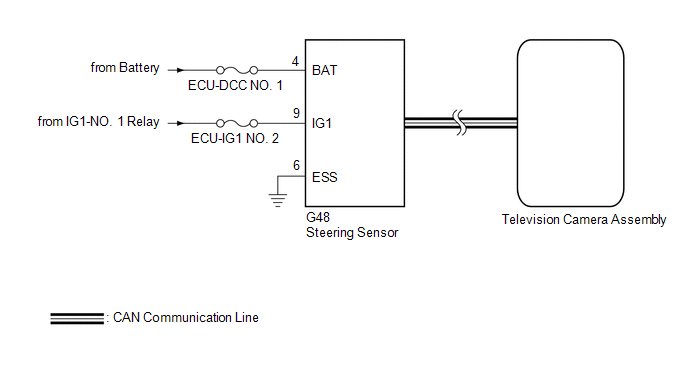
CAUTION / NOTICE / HINT
NOTICE:
- Inspect the fuses for circuits related to this system before performing the following procedure.
- Depending on the parts that are replaced or operations that are
performed during vehicle inspection or maintenance, calibration of other
systems as well as the parking assist monitor system may be needed.
Click here 
PROCEDURE
|
1. | CHECK HARNESS AND CONNECTOR (STEERING SENSOR POWER SOURCE) |
(a) Disconnect the G48 steering sensor connector.
(b) Measure the voltage according to the value(s) in the table below.
Standard Voltage:
|
Tester Connection | Condition |
Specified Condition |
|
G48-9 (IG1) - G48-6 (ESS) |
Engine switch on (IG) |
11 to 14 V |
| NG |
 | REPAIR OR REPLACE HARNESS OR CONNECTOR |
|
OK |
 | |
| 2. |
CHECK HARNESS AND CONNECTOR (STEERING SENSOR POWER SOURCE) |
(a) Disconnect the G48 steering sensor connector.
(b) Measure the resistance according to the value(s) in the table below.
Standard Resistance:
|
Tester Connection | Condition |
Specified Condition |
|
G48-6 (ESS) - Body ground |
Always | Below 1 Ω |
(c) Measure the voltage according to the value(s) in the table below.
Standard Voltage:
|
Tester Connection | Condition |
Specified Condition |
|
G48-4 (BAT) - G48-6 (ESS) |
Always | 11 to 14 V |
| OK |
 | REPLACE STEERING SENSOR |
| NG |
 | REPAIR OR REPLACE HARNESS OR CONNECTOR |
Steering Angle Sensor Failure (C1626)
DESCRIPTION
This DTC is
stored if the television camera assembly receives a signal via CAN
communication from the steering sensor that indicates an internal
malfunction.
|
DTC No. | Detection Item |
DTC Detection Condition | Trouble Area |
|
C1626 | Steering Angle Sensor Failure |
A fail flag is transmitted from the steering sensor |
- Steering sensor
- Television camera assembly
|
CAUTION / NOTICE / HINT
NOTICE:
Depending
on the parts that are replaced or operations that are performed during
vehicle inspection or maintenance, calibration of other systems as well
as the parking assist monitor system may be needed.
Click here

PROCEDURE
(a) Clear the DTCs.
Chassis > Parking Assist Camera > Clear DTCs
(b) Recheck for DTCs and check that no DTCs are output.
Chassis > Parking Assist Camera > Trouble Codes
|
Result | Proceed to |
|
DTC C1626 is output | A |
|
DTC C1626 is not output |
B |
| B |
 | USE SIMULATION METHOD TO CHECK |
|
A |
 | |
| 2. |
REPLACE STEERING SENSOR |
(a) Replace the steering sensor with a new or known good one.
Click here 
|
NEXT |
 | |
(a) Clear the DTCs.
Chassis > Parking Assist Camera > Clear DTCs
(b) Recheck for DTCs and check that no DTCs are output.
Chassis > Parking Assist Camera > Trouble Codes
|
Result | Proceed to |
|
DTC C1626 is output | A |
|
DTC C1626 is not output |
B |
| A |
 | REPLACE TELEVISION CAMERA ASSEMBLY |
| B |
 | END |
Back Camera Initialization Incomplete (C1691)
DESCRIPTION
This DTC is
stored when the television camera assembly judges that the back camera
initial setting has not been memorized (television camera assembly
optical axis adjustment (back camera position setting) is incomplete).
|
DTC No. | Detection Item |
DTC Detection Condition | Trouble Area |
|
C1691 | Back Camera Initialization Incomplete |
Back
camera initial setting has not been memorized (television camera
assembly optical axis adjustment (back camera position setting) is
incomplete) |
- Television camera assembly optical axis adjustment (back camera position setting)
- Television camera assembly
|
CAUTION / NOTICE / HINT
NOTICE:
Depending
on the parts that are replaced or operations that are performed during
vehicle inspection or maintenance, calibration of other systems as well
as the parking assist monitor system may be needed.
Click here

PROCEDURE
(a)
Perform the following procedure depending on the memory conditions to
register the vehicle information into the television camera assembly.
(1) Television camera assembly optical axis adjustment (back camera position setting).
Click here 
|
NEXT |
 | |
(a) Clear the DTCs.
Chassis > Parking Assist Camera > Clear DTCs
(b) Recheck for DTCs and check that no DTCs are output.
Chassis > Parking Assist Camera > Trouble Codes
HINT:
- If DTC C1691 is output, perform the television camera assembly optical axis adjustment (back camera position setting) again.
- If DTC C1691 is still output after performing the television camera
assembly optical axis adjustment 3 times, replace the television camera
assembly.
|
Result | Proceed to |
|
DTC C1691 is output | A |
|
DTC C1691 is not output |
B |
| A |
 | REPLACE TELEVISION CAMERA ASSEMBLY |
| B |
 | END |
Steering Angle Initialization Incomplete (C1694)
DESCRIPTION
This DTC is
stored when the television camera assembly judges that the maximum
steering angle has not been memorized (steering angle setting is
incomplete).
|
DTC No. | Detection Item |
DTC Detection Condition | Trouble Area |
|
C1694 | Steering Angle Initialization Incomplete |
Maximum steering angle has not been memorized (steering angle setting is incomplete) |
- Steering angle setting
- Television camera assembly
|
CAUTION / NOTICE / HINT
NOTICE:
Depending
on the parts that are replaced or operations that are performed during
vehicle inspection or maintenance, calibration of other systems as well
as the parking assist monitor system may be needed.
Click here

PROCEDURE
(a)
Perform the following procedure depending on the memory conditions to
register the vehicle information into the television camera assembly.
(1) Steering angle setting.
Click here 
|
NEXT |
 | |
(a) Clear the DTCs.
Chassis > Parking Assist Camera > Clear DTCs
(b) Recheck for DTCs and check that no DTCs are output.
Chassis > Parking Assist Camera > Trouble Codes
HINT:
- If DTC C1694 is output, perform the steering angle setting again.
- If DTC C1694 is still output after performing the steering angle setting 3 times, replace the television camera assembly.
|
Result | Proceed to |
|
DTC C1694 is output | A |
|
DTC C1694 is not output |
B |
| A |
 | REPLACE TELEVISION CAMERA ASSEMBLY |
| B |
 | END |
Calibration
CALIBRATION
ADJUST PARKING ASSIST MONITOR SYSTEM
(a) The parking assist monitor system can be adjusted using diagnostic mode.
(b) If the following operations are performed, it is necessary to perform adjustments and checks using diagnostic mode.
|
Part Name | Operation |
Adjustment Item | Proceed to |
|
Steering sensor |
- Replacement
- Removal and installation of the steering sensor
- Removal and installation of the connector of the steering sensor
| Steering angle neutral point (Initialize parking assist monitor system) |
 |
|
Steering angle setting |
Procedure 3 |
|
Suspension, tires, etc. |
Replacement (The vehicle height changes due to suspension or tire replacement) |
Television camera assembly optical axis (Back camera position setting) |
Procedure 2 |
|
Television camera assembly |
Replacement | Parking assist monitor system initialization |
Procedure 1 |
| Removal
and installation of the television camera assembly etc. (Installation
angle of the television camera assembly changes due to removal and
installation) | Television camera assembly optical axis (Back camera position setting) |
Procedure 2 |
HINT:
The
adjustment values stored while performing parking assist monitor system
calibration are stored in the television camera assembly.
PARKING ASSIST MONITOR SYSTEM INITIALIZATION (PROCEDURE 1)
HINT:
- Be sure to check for DTCs before performing this procedure.
Click here 
- Illustrations may differ from the actual vehicle screen depending on the
device settings and options. Therefore, some detailed areas may not be
shown exactly the same as on the actual vehicle screen.
(a) Preparation for adjustment
(1) Park the vehicle with the steering wheel centered.
(2)
Set a target bar behind the vehicle for optical axis adjustment of the
television camera assembly (back camera position setting).
HINT:
Create a target bar for adjustment only when adjusting the optical axis of the television camera assembly.

|
*a | Vehicle Center |
|
*b | Target Bar for Back Camera Position Setting |
|
*c | Vehicle End |
|
*d | Front |
Dimension:
|
Area | Specification |
|
A | 1055 mm (3.460 ft.) |
|
B | 1995 to 2005 mm (6.544 to 6.576 ft.) |
HINT:
- Set a piece of tape on the ground as the target bar for adjustment. Its
width and length should be 20 to 30 mm (0.787 to 1.180 in.) and 1995 to
2005 mm (6.544 to 6.576 ft.), respectively.
- Before parking the vehicle, be sure to move the vehicle forward and in
reverse to check that the tires are facing straight ahead with the
steering wheel centered.
- Check that the luggage compartment door is fully closed.
(b) Start diagnostic mode.
NOTICE:
The
following must be carried out with the engine started. Apply the
parking brake, depress the brake pedal, check that the shift lever is in
P, and ensure that the vehicle is not moving.
(1) Select "Function Check/Setting" on the "Service Menu" screen.
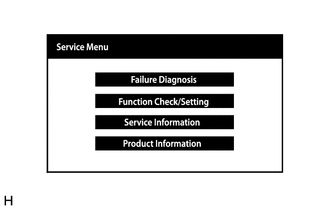
(2) Select "Camera Setting" on the "Function Check/Setting I" screen.
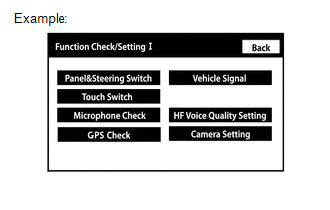
(3) Select "Next" on the "Signal Check" screen.
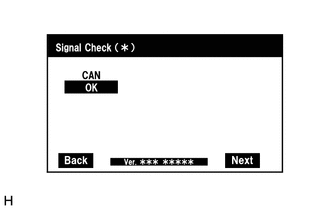
HINT:
- When "CHK" (red) is displayed for any items on the "Signal Check"
screen, selecting "Next" will not change the screen to the "Steering
Angle Setting" screen.
- When "CHK" (red) is displayed for any items on the "Signal Check" screen, perform inspections using the "Signal Check" screen.
Click here 
(c) Steering Angle Setting
(1) Check that the steering wheel is centered (approximately +/- 5 degrees or less) and then select "Steering Center Memorize".
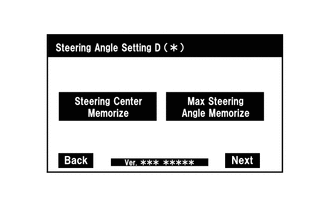
HINT:
When performing removal and installation of the television camera assembly, steering angle setting is not required.
(2)
After performing the steering center memorize operation, turn the
steering wheel to the left and right lock positions and select "Max
Steering Angle Memorize". The maximum steering angle is then stored and
the screen changes to the "Back Camera Position Setting D (*)" screen.
HINT:
- The "Next" does not respond until the system memorizes the steering center and maximum steering wheel angle.
- It is also possible to start by initially turning the steering to the right side.
- When "Max Steering Angle Memorize" is selected, a beep will sound to confirm that the adjustment values have been stored.
- The adjustment values will not be stored unless "Max Steering Angle
Memorize" is selected after turning the steering wheel from lock to
lock.
- When "Back" is selected, the screen changes to the "Signal Check" screen without storing any values.
- Even if no DTCs are detected, selecting "Max Steering Angle Memorize"
may not cause the adjustment values to be stored if the steering sensor
is malfunctioning.
- If selecting "Max Steering Angle Memorize" does not cause the adjustment
value to be stored after performing the steering angle setting
procedure, replace the steering sensor.
Click here 
(d) Back Camera Position Setting
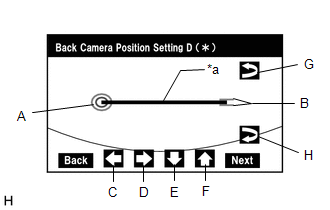
|
*a | Target Bar for Back Camera Position Setting |
HINT:
- When the luggage compartment door is open, the "You can not calibrate
the camera when the door is open. Please close the door." message will
be displayed and camera position setting will not be possible.
- If the "You can not calibrate the camera when the door is open. Please
close the door." message is displayed even when the luggage compartment
door is closed, perform inspections according to Problem Symptoms Table
(When adjusting the camera optical axis, "You can not calibrate the
camera when the door is open. Please close the door." is displayed even
after the luggage compartment door has been closed).
Click here 
(1) Perform vertical and horizontal position adjustment.
- Move the circle (A) left, right, up and down by selecting the buttons
(C), (D), (E) and (F) so that the left end of Target Bar for Back Camera
Position Setting is positioned within the center of the circle (A)
(center of the inner red circle).
(2) Perform roll angle adjustment.
- Rotate the bar (B) by selecting the buttons (G) or (H) so that the bar
(B) becomes parallel to Target Bar for Back Camera Position Setting.
(3) Select "Next" on the "Back Camera Position Setting D (*)" screen.
(e) Back Verify Mode
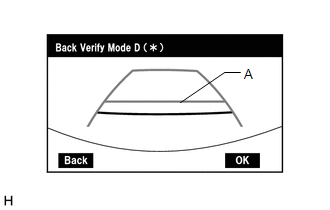
(1) Check that (A) and the target adjustment bar are overlapping.
- If the lines are not aligned, perform the "Steering Center Memorize" and "Max Steering Angle Memorize" operations.
- If (A) and the target adjustment bar are not aligned even if the tires
are aligned straight ahead, perform the back camera position setting
operation.
(2) Select "OK" to return to the "Function Check/Setting I" screen and complete the adjustment.
HINT:
- The update is not completed until "OK" is selected.
- When "OK" is selected, a beep will sound to confirm that the adjustment values have been stored.
- The adjustment values are not stored until the beep has sounded.
(f) Finish diagnostic mode.
- w/o Navigation System: Click here

- w/ Navigation System: Click here

(g) Confirm steering angle adjustment.
HINT:
If
the steering angle has been adjusted, confirm the steering angle
adjustment on the parking assist monitor screen after finishing
diagnostic mode.
(1) Check on the parking assist
screen that the estimated course line moves until the steering wheel is
fully turned to either the left or right.
HINT:
If
the estimated course line stops moving before the steering wheel is
fully turned to either the left or right, the steering angle adjustment
values have not been stored correctly. In this case, perform "Steering
Center Memorize" and "Max Steering Angle Memorize" again.
BACK CAMERA POSITION SETTING (PROCEDURE 2)
HINT:
- Be sure to check for DTCs before performing this procedure.
Click here 
- Illustrations may differ from the actual vehicle screen depending on the
device settings and options. Therefore, some detailed areas may not be
shown exactly the same as on the actual vehicle screen.
(a) Preparation for adjustment
(1) Park the vehicle with the steering wheel centered.
(2)
Set a target bar behind the vehicle for optical axis adjustment of the
television camera assembly (back camera position setting).
HINT:
Create a target bar for adjustment only when adjusting the optical axis of the television camera assembly.

|
*a | Vehicle Center |
|
*b | Target Bar for Back Camera Position Setting |
|
*c | Vehicle End |
|
*d | Front |
Dimension:
|
Area | Specification |
|
A | 1055 mm (3.460 ft.) |
|
B | 1995 to 2005 mm (6.544 to 6.576 ft.) |
HINT:
- Set a piece of tape on the ground as the target bar for adjustment. Its
width and length should be 20 to 30 mm (0.787 to 1.180 in.) and 1995 to
2005 mm (6.544 to 6.576 ft.), respectively.
- Before parking the vehicle, be sure to move the vehicle forward and in
reverse to check that the tires are facing straight ahead with the
steering wheel centered.
- Check that the luggage compartment door is fully closed.
(b) Start diagnostic mode.
NOTICE:
The
following must be carried out with the engine started. Apply the
parking brake, depress the brake pedal, check that the shift lever is in
P, and ensure that the vehicle is not moving.
(1) Select "Function Check/Setting" on the "Service Menu" screen.

(2) Select "Camera Setting" on the "Function Check/Setting I" screen.

(3) Select "Back Camera Setting" on the "Mode Setting" screen.
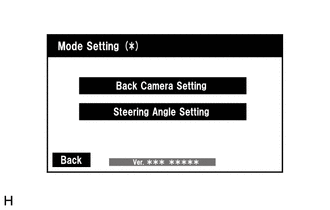
HINT:
To select a grayed out item, select and hold the item for 2 seconds or more.
(4) Select "Next" on the "Signal Check" screen.

HINT:
- When "CHK" (red) is displayed for any items on the "Signal Check"
screen, selecting "Next" will not change the screen to the "Back Camera
Position Setting D (*)" screen.
- When "CHK" (red) is displayed for any items on the "Signal Check" screen, perform inspections using the "Signal Check" screen.
Click here 
(c) Back Camera Position Setting

|
*a | Target Bar for Back Camera Position Setting |
HINT:
- When the luggage compartment door is open, the "You can not calibrate
the camera when the door is open. Please close the door." message will
be displayed and camera position setting will not be possible.
- If the "You can not calibrate the camera when the door is open. Please
close the door." message is displayed even when the luggage compartment
door is closed, perform inspections according to Problem Symptoms Table
(When adjusting the camera optical axis, "You can not calibrate the
camera when the door is open. Please close the door." is displayed even
after the luggage compartment door has been closed).
Click here 
(1) Perform vertical and horizontal position adjustment.
- Move the circle (A) left, right, up and down by selecting the buttons
(C), (D), (E) and (F) so that the left end of Target Bar for Back Camera
Position Setting is positioned within the center of the circle (A)
(center of the inner red circle).
(2) Perform roll angle adjustment.
- Rotate the bar (B) by selecting the buttons (G) or (H) so that the bar
(B) becomes parallel to Target Bar for Back Camera Position Setting.
(3) Select "Next" on the "Back Camera Position Setting D (*)" screen.
(d) Back Verify Mode

(1) Check that (A) and the target adjustment bar are overlapping.
- If the lines are not aligned, perform the "Steering Center Memorize" and "Max Steering Angle Memorize" operations.
- If (A) and the target adjustment bar are not aligned even if the tires
are aligned straight ahead, perform the back camera position setting
operation.
(2) Select "OK" to return to the "Mode Setting" screen and complete the adjustment.
HINT:
- The update is not completed until "OK" is selected.
- When "OK" is selected, a beep will sound to confirm that the adjustment values have been stored.
- The adjustment values are not stored until the beep has sounded.
(e) Finish diagnostic mode.
STEERING ANGLE SETTING (PROCEDURE 3)
HINT:
- If the vehicle width extension guide lines and estimated course lines
are not aligned when the steering wheel is centered, or if the estimated
course line does not move before the steering wheel is fully turned to
either the left or right, perform Steering Angle Setting.
- Be sure to check for DTCs before performing this procedure.
Click here 
- Illustrations may differ from the actual vehicle screen depending on the
device settings and options. Therefore, some detailed areas may not be
shown exactly the same as on the actual vehicle screen.
(a) Center the steering wheel and stop the vehicle.
(b) Start diagnostic mode.
NOTICE:
The
following must be carried out with the engine started. Apply the
parking brake, depress the brake pedal, check that the shift lever is in
P, and ensure that the vehicle is not moving.
(1) Select "Function Check/Setting" on the "Service Menu" screen.

(2) Select "Camera Setting" on the "Function Check/Setting I" screen.

(3) Select "Steering Angle Setting" on the "Mode Setting" screen.

HINT:
To select a grayed out item, select and hold the item for 2 seconds or more.
(4) Select "Next" on the "Signal Check" screen to display the "Steering Angle Setting" screen.

HINT:
- When "CHK" (red) is displayed for any items on the "Signal Check"
screen, selecting "Next" will not change the screen to the "Steering
Angle Setting" screen.
- When "CHK" is displayed for any items on the "Signal Check" screen, perform inspections using the "Signal Check" screen.
Click here 
(c) Steering Angle Setting
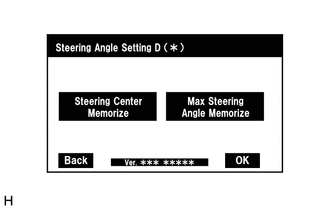
(1) Check that the steering wheel is centered (approximately +/- 5 degrees or less) and select "Steering Center Memorize".
HINT:
When performing removal and installation of the television camera assembly, steering angle setting is not required.
(2)
After the centered steering position is memorized, turn the steering
wheel to the left and then to the right full lock positions and select
"Max Steering Angle Memorize".
HINT:
It is also possible to start by initially turning the steering wheel to the right side.
(3)
Select "Max Steering Angle Memorize" to store the steering angle
adjustment value and change the screen to the "Mode Setting" screen.
HINT:
- When "Max Steering Angle Memorize" is selected, a beep will sound to
confirm that the steering angle adjustment values have been stored.
- The adjustment values will not be stored unless "Max Steering Angle Memorize" is selected.
- When "Back" is selected, the screen changes to "Signal Check" without storing the set values.
- If the Steering Angle Settings have not been adjusted, selecting "Max
Steering Angle Memorize" will not cause the adjustment values to be
stored.
- Even if no DTCs are detected, selecting "Max Steering Angle Memorize"
may not cause the adjustment value to be stored if the steering sensor
is malfunctioning.
- If selecting "Max Steering Angle Memorize" does not cause the adjustment
value to be stored after adjusting the steering angle, replace the
steering sensor.
Click here 
(d) Finish diagnostic mode.
(e) Confirm steering angle adjustment.
HINT:
If
the steering angle has been adjusted, confirm the steering angle
adjustment on the parking assist monitor screen after finishing
diagnostic mode.
(1) Check on the parking assist
screen that the estimated course line moves until the steering wheel is
fully turned to either the left or right.
HINT:
If
the estimated course line stops moving before the steering wheel is
fully turned to either the left or right, the steering angle adjustment
values have not been stored correctly. In this case, perform "Steering
Center Memorize" and "Max Steering Angle Memorize" again.
Data List / Active Test
DATA LIST / ACTIVE TEST
DATA LIST
NOTICE:
In
the table below, the values listed under "Normal Condition" are
reference values. Do not depend solely on these reference values when
deciding whether a part is faulty or not.
HINT:
Using
the Techstream to read the Data List allows the values or states of
switches, sensors, actuators and other items to be read without removing
any parts. This non-intrusive inspection can be very useful because
intermittent conditions or signals may be discovered before parts or
wiring is disturbed. Reading the Data List information early in
troubleshooting is one way to save diagnostic time.
(a) Connect the Techstream to the DLC3.
(b) Turn the engine switch on (IG).
(c) Turn the Techstream on.
(d) Enter the following menus: Chassis / Parking Assist Camera / Data List.
(e) Read the Data List according to the display on the Techstream.
Chassis > Parking Assist Camera > Data List
|
Tester Display | Measurement Item |
Range | Normal Condition |
Diagnostic Note |
|
Video Output Status | Output condition of video signal |
OK or NG | OK: Output condition of video signal is normal
NG: Output condition of video signal is abnormal |
- |
| HV/ENG Data Check |
Verification of the HV/ENG data |
OK or NG | OK: Data verification normal
NG: Data verification abnormal |
- |
| Destination Data Check |
Verification of destination data |
OK or NG | OK: Data verification normal
NG: Data verification abnormal |
- |
| RHD/LHD Signal Check |
Verification of RHD/LHD signal |
OK or NG | OK: Output condition of RHD/LHD signal is normal
NG: Output condition of RHD/LHD signal is abnormal |
- |
| EEPROM Status (Initial read) |
Television camera assembly information |
OK or NG | OK: Television camera assembly normal
NG: Television camera assembly abnormal |
- |
| CPU Communication Status |
Television camera assembly information |
OK or NG | OK: Television camera assembly normal
NG: Television camera assembly abnormal |
- |
| Number of DTC |
Number of stored DTCs | min.: 0, max.: 255 |
Number of DTCs will be displayed |
- |
| Current Key Cycle |
Cumulative number of times the engine switch was turned on (IG) |
Min.: 0, Max.: 65535 time |
Cumulative number of times the engine switch was turned on (IG) will be displayed |
- |
| Current Key Cycle Elapsed Time |
Time elapsed since the engine switch was turned on (IG) |
Min.: 0, Max.: 1677721.5 s |
Time elapsed since the engine switch was turned on (IG) will be displayed |
- |
Diagnosis System
DIAGNOSIS SYSTEM
PARKING ASSIST MONITOR SYSTEM DIAGNOSTIC MODE
(a)
In diagnostic mode for the parking assist monitor system, signals
received by the radio and display receiver assembly can be checked and
the parking assist monitor system can be calibrated, adjusted and
checked using the multi-display.
NOTICE:
Depending
on the parts that are replaced or operations that are performed during
vehicle inspection or maintenance, calibration of other systems as well
as the parking assist monitor system may be needed.
Click here

HINT:
The displayed items may differ depending on vehicle specifications.
DIAGNOSIS SCREEN TRANSITION (DURING PARKING ASSIST MONITOR SYSTEM INITIALIZATION)
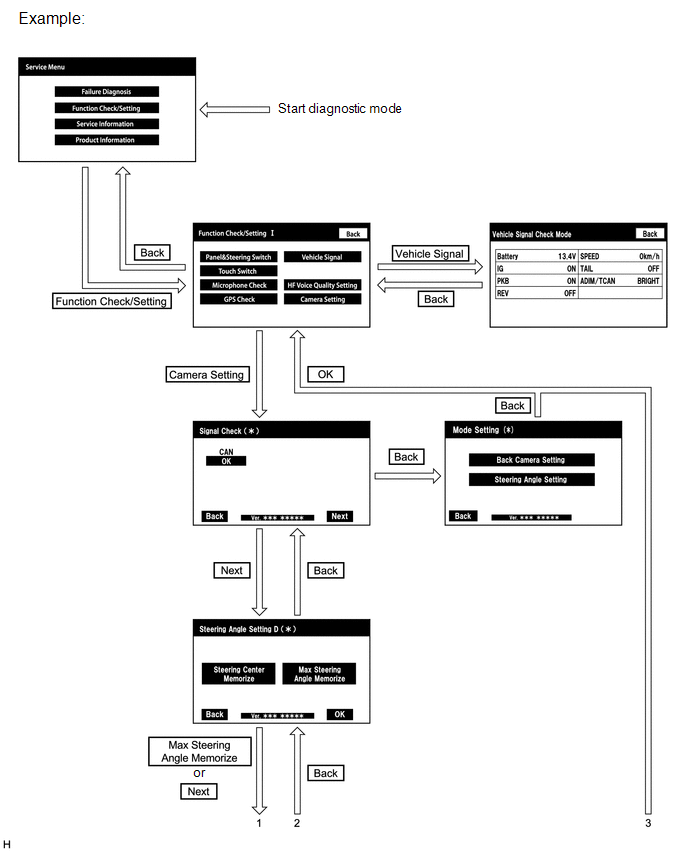
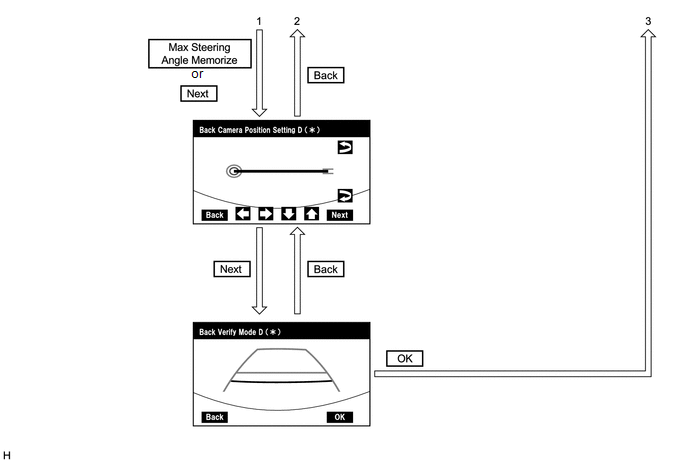
DIAGNOSIS SCREEN TRANSITION (AFTER PARKING ASSIST MONITOR SYSTEM INITIALIZATION)
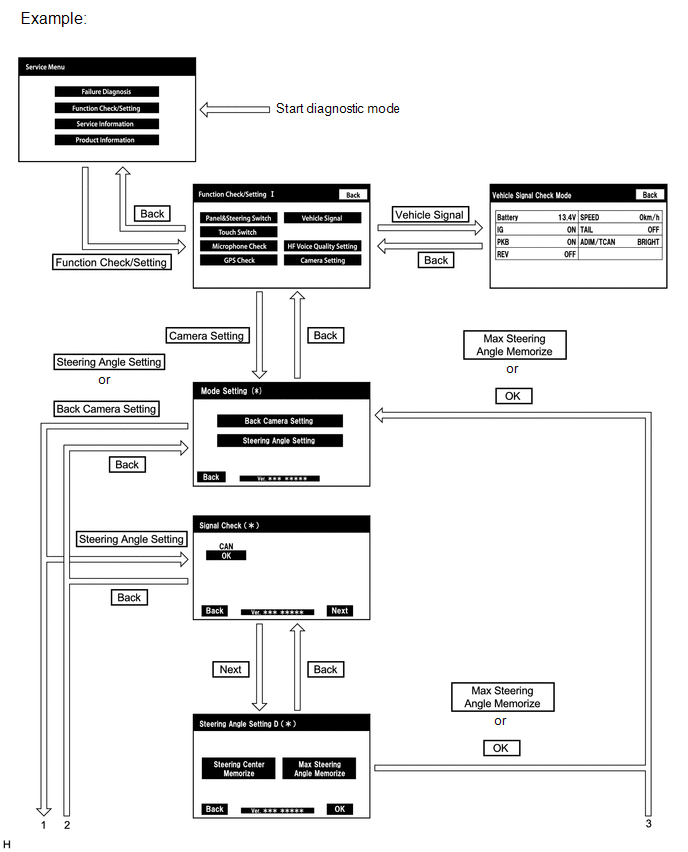

VEHICLE SIGNAL CHECK
HINT:
Illustrations
may differ from the actual vehicle screen depending on the device
settings and options. Therefore, some detailed areas may not be shown
exactly the same as on the actual vehicle screen.
(a) Start diagnostic mode.
(b) Select "Function Check/Setting" on the "Service Menu" screen to display the "Function Check/Setting I" screen.
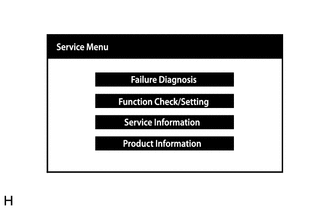
(c) Select "Vehicle Signal" on the "Function Check/Setting I" screen.
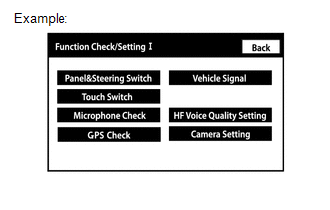
(d) Vehicle Signal Check Mode
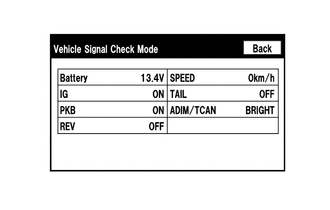
(1) When the "Vehicle Signal Check Mode" screen is displayed, check the item displayed for "REV".
HINT:
- Only conditions having inputs are displayed.
- This screen displays vehicle signals input to the radio and display receiver assembly.
(e) Finish diagnostic mode.
HINT:
Illustrations
may differ from the actual vehicle screen depending on the device
settings and options. Therefore, some detailed areas may not be shown
exactly the same as on the actual vehicle screen.
SIGNAL CHECK (PARKING ASSIST MONITOR SYSTEM INPUT SIGNALS)
(a) Start diagnostic mode.
(1) Select "Function Check/Setting" on the "Service Menu" screen to display the "Function Check/Setting I" screen.

(2) Select "Camera Setting" on the "Function Check/Setting I" screen.
HINT:
After
"Camera Setting" is selected, the screen transitions differ depending
on whether initialization of the parking assist monitor system was
performed after the television camera assembly was replaced.
|
Parking Assist Monitor System Initialization |
Screen Transition |
| Not performed |
Signal Check screen |
| Performed |
Mode Setting screen |

(3) When the screen changes to the "Mode Setting" screen, select "Back Camera Setting" to display the "Signal Check" screen.
HINT:
To select a grayed out item, select and hold the item for 2 seconds or more.
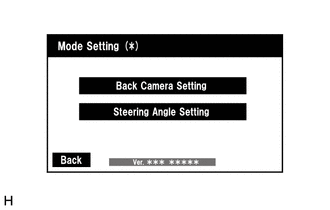
(b) Signal Check
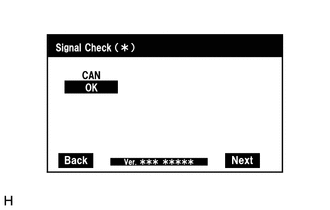
(1) On the "Signal Check" screen, it is possible to inspect the state of signals and check the settings.
|
Item | Inspection Detail |
Note |
| CAN |
CAN communication signal input | When "CHK" (red) is displayed, selecting "Next" will not change the screen to the next screen. |
HINT:
- When "CHK" (red) is displayed, perform inspections based on the result of the following inspections.
- If performing the adjustment after proceeding to the next screen,
confirm that all items display "OK" (blue) before selecting "Next".
(c) CAN inspection
HINT:
If "CHK" (red) is displayed for "CAN", check for DTCs and perform troubleshooting based on the output DTCs.
Click here 
(d) Finish diagnostic mode.
CAMERA SYNCHRONOUS ERROR HISTORY
HINT:
This function is used to check the date and time of occurrence when a camera synchronous error occurs.
(a) Check camera synchronous error history.
(1) Connect the Techstream to the DLC3.
(2) Turn the engine switch on (IG).
(3) Turn the Techstream on.
(4) Enter the following menus: Body Electrical / Navigation System / Utility / Camera Synchronous Error History.
Body Electrical > Navigation System > Utility
|
Tester Display |
| Camera Synchronous Error History |
(5)
When an item is stored for Camera Synchronous Error History, record it
before repairing the radio and display receiver assembly and television
camera assembly.
HINT:
Camera
Synchronous Error History can store up to 5 history data items. If a
new camera synchronous error occurs when 5 data items have already been
stored, the oldest data is cleared and the new data is stored.
(b) Clear camera synchronous error history.
(1) When DTCs are cleared using any of the following operations, Camera Synchronous Error History will be cleared as well.
- Cleared using the Techstream.
- Cleared using the system check mode screen.
- Cleared using the unit check mode screen.
VIDEO DEVICE CONNECTION CHECK
CALIBRATION WHEN SERVICING VEHICLE
NOTICE:
Depending
on the parts that are replaced or operations that are performed during
vehicle inspection or maintenance, calibration of other systems as well
as the parking assist monitor system may be needed.
Click here

Diagnostic Trouble Code Chart
DIAGNOSTIC TROUBLE CODE CHART
Parking Assist Monitor System |
DTC No. | Detection Item |
Link |
| C1611 |
ECU Malfunction |
 |
|
C1621 | Back Camera Power Supply Failure |
 |
|
C1622 | Back Camera Disconnected |
 |
|
C1625 | Open or Short in Steering Angle Sensor +B |
 |
|
C1626 | Steering Angle Sensor Failure |
 |
|
C168D | Vehicle Information Unmatched |
 |
|
C1691 | Back Camera Initialization Incomplete |
 |
|
C1694 | Steering Angle Initialization Incomplete |
 |
|
U0100 | Lost Communication with ECM / PCM "A" |
 |
|
U0126 | Lost Communication with Steering Angle Sensor Module |
 |
|
U0140 | Lost Communication with Body Control Module |
 |
|
U0163 | Lost Communication with Navigation Control Module |
 |
|
U0233 | Lost Communication with Blind Spot Monitor Master Module |
 |
|
U1000 | CAN Communication Failure (Message Registry) |
 |
Dtc Check / Clear
DTC CHECK / CLEAR
CHECK DTC
(a) Connect the Techstream to the DLC3.
(b) Turn the engine switch on (IG).
(c) Turn the Techstream on.
(d) Enter the following menus: Chassis / Parking Assist Camera / Trouble Codes.
Chassis > Parking Assist Camera > Trouble Codes
(e) Enter the following menus: Body Electrical / Navigation System / Trouble Codes.
Body Electrical > Navigation System > Trouble Codes
(f) Check for DTCs.
Click here 
NOTICE:
The
radio and display receiver assembly outputs DTCs for the following
system. When DTCs other than those in Diagnostic Trouble Code Chart for
the parking assist monitor system are output, refer to Diagnostic
Trouble Code Chart for the relevant systems.
|
System | Proceed to |
|
Audio and Visual System*1 |
 |
|
Navigation System*2 |
 |
- *1: w/o Navigation System
- *2: w/ Navigation System
CLEAR DTC
(a) Connect the Techstream to the DLC3.
(b) Turn the engine switch on (IG).
(c) Turn the Techstream on.
(d) Enter the following menus: Chassis / Parking Assist Camera / Trouble Codes.
Chassis > Parking Assist Camera > Clear DTCs
(e) Enter the following menus: Body Electrical / Navigation System / Trouble Codes.
Body Electrical > Navigation System > Clear DTCs
(f) Clear the DTCs.
How To Proceed With Troubleshooting
CAUTION / NOTICE / HINT
HINT:
- Use the following procedure to troubleshoot the parking assist monitor system.
- *: Use the Techstream.
PROCEDURE
|
1. | VEHICLE BROUGHT TO WORKSHOP |
|
NEXT |
 | |
| 2. |
CUSTOMER PROBLEM ANALYSIS |
(a)
Ask the customer about the problems and the conditions at the time the
malfunction occurred to make sure the problem symptom was not
temporarily caused by radio waves in the surrounding environment.
HINT:
The parking assist monitor display may be temporarily distorted due to radio waves around the vehicle.
|
Problem Symptom | Cause |
|
*: DTCs output as "Hist" will not be output again after DTCs are cleared.
|
Both of the following conditions are met:
- The problem symptom indicates a parking assist monitor display malfunction and the problem symptom cannot be reproduced.
- DTC C1622 is output as "Hist" only.*
| The
display may be temporarily distorted when the vehicle is close to an
object that transmits radio waves, such as a telecommunication tower, an
airport or a truck equipped with a transceiver. |
|
NEXT |
 | |
| 3. |
INSPECT BATTERY VOLTAGE |
(a) Measure the battery voltage.
Standard Voltage:
11 to 14 V
If the voltage is below 11 V, replace or recharge the battery before proceeding to the next step.
|
NEXT |
 | |
(a) Check the vehicle specification.
|
Result | Proceed to |
|
w/ Navigation System |
A |
| w/o Navigation System |
B |
| B |
 | GO TO STEP 6 |
|
A |
 | |
| 5. |
CHECK NAVIGATION SYSTEM |
(a) Refer to Navigation System.
Click here 
|
Result | Proceed to |
|
Navigation system is normal |
A |
| Navigation system is abnormal |
B |
| A |
 | GO TO STEP 7 |
| B |
 | GO TO NAVIGATION SYSTEM |
| 6. |
CHECK AUDIO AND VISUAL SYSTEM |
(a) Refer to Audio and Visual System.
Click here 
|
Result | Proceed to |
|
Audio and visual system is normal |
A |
| Audio and visual system is abnormal |
B |
| B |
 | GO TO AUDIO AND VISUAL SYSTEM |
|
A |
 | |
| 7. |
CHECK COMMUNICATION FUNCTION OF CAN COMMUNICATION SYSTEM* |
(a) Use the Techstream to check if the CAN communication system is functioning normally.
Click here 
|
Result | Proceed to |
|
CAN communication system DTCs are not output |
A |
| CAN communication system DTCs are output |
B |
| B |
 | GO TO CAN COMMUNICATION SYSTEM |
|
A |
 | |
(a) Check for DTCs and make a note of any codes that are output.
Chassis > Parking Assist Camera > Trouble Codes Body Electrical > Navigation System > Trouble Codes
(b) Clear the DTCs.
Chassis > Parking Assist Camera > Clear DTCs Body Electrical > Navigation System > Clear DTCs
(c) Recheck for DTCs. Try to prompt the DTC by simulating the original activity that the DTC suggests.
Chassis > Parking Assist Camera > Trouble Codes Body Electrical > Navigation System > Trouble Codes
|
Result | Proceed to |
|
No DTCs are output | A |
|
DTCs are output | B |
| B |
 | GO TO STEP 11 |
|
A |
 | |
| 9. |
PROBLEM SYMPTOMS TABLE |
(a) Refer to Problem Symptoms Table.
Click here 
|
Result | Proceed to |
|
Fault is not listed in Problem Symptoms Table |
A |
| Fault is listed in Problem Symptoms Table |
B |
| B |
 | GO TO STEP 11 |
|
A |
 | |
| 10. |
OVERALL ANALYSIS AND TROUBLESHOOTING |
(a) Diagnosis System
Click here 
(b) Terminals of ECU
Click here 
(c) Data List / Active Test
Click here 
|
NEXT |
 | |
| 11. |
ADJUST, REPAIR OR REPLACE |
|
NEXT |
 | |
| NEXT |
 | END |
Image from Camera for Parking Assist Monitor is Abnormal
DESCRIPTION
The video signal from the television camera assembly is transmitted to the radio and display receiver assembly.
WIRING DIAGRAM
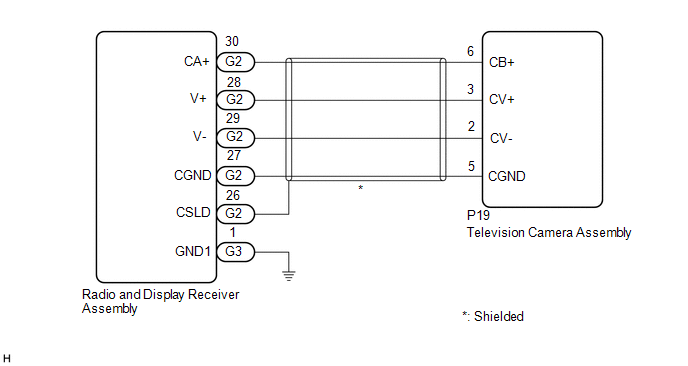
CAUTION / NOTICE / HINT
NOTICE:
Depending
on the parts that are replaced or operations that are performed during
vehicle inspection or maintenance, calibration of other systems as well
as the parking assist monitor system may be needed.
Click here

HINT:
Images may be unclear even in normal conditions if:
- Electrical devices are used in the cabin (noise may occur in the image).
- Accessories that generate radio waves have been installed (noise may occur in the image).
- The outer mirror switch assembly is operated (noise may occur in the image).
- The multi-display is cold (the image immediately after turning the engine switch on (IG) may be blurred or darker than normal).
- The camera lens is dirty with snow, mud, etc.
- A strong beam of light, such as a sunbeam or headlight, hits the camera.
- It is too dark around the camera (at night etc.).
- The ambient temperature around the camera is either too high or too low.
- The vehicle is tilted at a steep angle.
- The television camera assembly lens is scratched.
- The television camera assembly lens has drops of water on it or the humidity is high.
- When the camera is used under fluorescent lights, sodium lights, or
mercury lights etc., the lights and the illuminated area may appear to
flicker.
PROCEDURE
|
1. | CHECK HARNESS AND CONNECTOR (RADIO AND DISPLAY RECEIVER ASSEMBLY - TELEVISION CAMERA ASSEMBLY) |
Click here 
| NG |
 | REPAIR OR REPLACE HARNESS OR CONNECTOR |
|
OK |
 | |
| 2. |
REPLACE TELEVISION CAMERA ASSEMBLY |
(a) Replace the television camera assembly with a new or known good one.
Click here 
(b) Check that the parking assist monitor system operates normally.
OK:
Parking assist monitor system operates normally.
| OK |
 | END |
| NG |
 | REPLACE RADIO AND DISPLAY RECEIVER ASSEMBLY |
Initialization
INITIALIZATION
INITIALIZE PARKING ASSIST MONITOR SYSTEM
(a)
When "!" mark is displayed on the image of the area behind the vehicle,
perform the following procedure to correct the steering angle neutral
point.
(1) Fully turn the steering wheel to the right and left on flat ground.
NOTICE:
Memorizing
the steering angle neutral point must be carried out with the engine
started. Apply the parking brake, depress the brake pedal, check that
the shift lever is in P, and ensure that the vehicle is not moving.
HINT:
If
"!" mark is displayed on the image of the area behind the vehicle with
the steering wheel fully turned to the right or left, perform "Steering
Angle Setting in Calibration".
Click here 
Parts Location
PARTS LOCATION
ILLUSTRATION
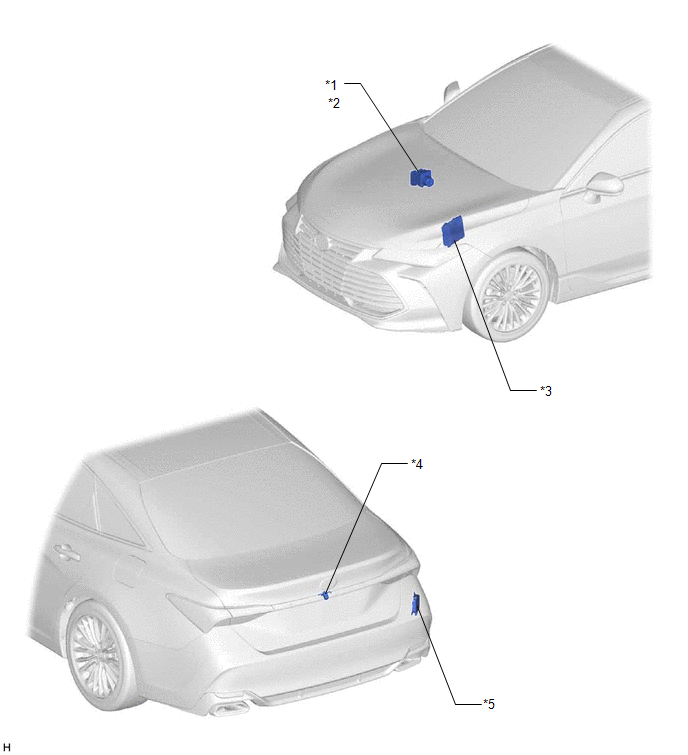
|
*1 | BRAKE ACTUATOR ASSEMBLY |
*2 | - SKID CONTROL ECU |
|
*3 | ECM |
*4 | TELEVISION CAMERA ASSEMBLY |
|
*5 | BLIND SPOT MONITOR SENSOR RH |
- | - |
ILLUSTRATION
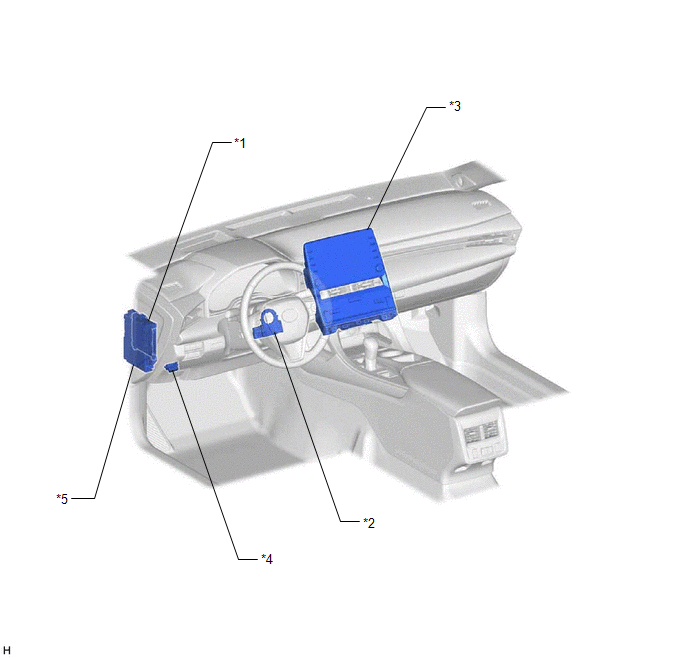
|
*1 | MAIN BODY ECU (MULTIPLEX NETWORK BODY ECU) |
*2 | STEERING SENSOR |
|
*3 | RADIO AND DISPLAY RECEIVER ASSEMBLY |
*4 | DLC3 |
|
*5 | INSTRUMENT PANEL JUNCTION BLOCK ASSEMBLY
- ECU-IG1 NO. 2 FUSE - ECU-DCC NO. 1 FUSE - ECU-ACC FUSE
- BKUP LP RELAY - IG1-NO. 1 RELAY |
- | - |
Precaution
PRECAUTION
PRECAUTION FOR DISCONNECTING CABLE FROM NEGATIVE BATTERY TERMINAL
NOTICE:
When
disconnecting the cable from the negative (-) battery terminal,
initialize the following systems after the cable is reconnected.
|
System Name | See Procedure |
|
Lane Departure Alert System (w/ Steering Control) |
 |
|
Intelligent Clearance Sonar System |
|
Parking Assist Monitor System |
|
Panoramic View Monitor System |
|
Pre-collision System |
|
Lighting System (for Gasoline Model with Cornering Light) |
POINTS TO NOTE WHEN SERVICING
(a) Pay attention to the following points when servicing.
(1)
Depending on the parts that are replaced or operations that are
performed during vehicle inspection or maintenance, calibration of other
systems as well as the parking assist monitor system may be needed.
Click here

HINT:
Each adjusted value for the calibration of the parking assist monitor system will be stored in the television camera assembly.
(2)
When the lens of the television camera assembly is dirty, wash the lens
with water and wipe it off with a soft cloth to obtain clear images.
For heavy dirt, use neutral detergent to clean the lens.
NOTES FOR TELEVISION CAMERA ASSEMBLY
(a) Notes for the television camera assembly
(1) The parking assist monitor system may not function properly if subjected to a severe blow by any hard object.
(2) Do not scrub the camera lens. Scrubbing may scratch the camera lens and affect the image.
(3)
The cover part of the camera is made of resin. Prevent organic
solvents, waxes, bond removing solvents or glass coating from adhering
to the cover. If such material adheres to the cover, clean it off
immediately and wash it with water.
(4) Exposing the camera to a sudden temperature change may affect proper functioning of the camera.
(5)
A clear image may not appear if the camera is dirty with snow, mud,
etc. In that case, wash it with water and wipe off the lens. Use a
detergent to remove dirt if necessary.
(6) When
washing the vehicle with a high-pressure washer, do not spray water on
the television camera assembly or surrounding area. High-pressure water
can damage the camera.
(b) Images may be unclear even in normal conditions if:
(1) Electrical devices are used in the cabin (noise may occur in the image).
(2) Accessories that generate radio waves have been installed (noise may occur in the image).
(3) The outer mirror switch assembly is operated (noise may occur in the image).
(4)
The multi-display is cold (the image immediately after turning the
engine switch on (IG) may be blurred or darker than normal).
(5) The camera lens is dirty with snow, mud, etc.
(6) A strong beam of light, such as a sunbeam or headlight, hits the camera.
(7) It is too dark around the camera (at night etc.).
(8) The ambient temperature around the camera is either too high or too low.
(9) The vehicle is tilted at a steep angle.
(10) The television camera assembly lens is scratched.
(11) The television camera assembly lens has drops of water on it or the humidity is high.
(12)
When the camera is used under fluorescent lights, sodium lights, or
mercury lights etc., the lights and the illuminated area may appear to
flicker.
Problem Symptoms Table
PROBLEM SYMPTOMS TABLE
NOTICE:
- The following inspection procedures for the parking assist monitor
system are based on the assumption that the audio and visual system*1 or
navigation system*2 is normal. If the audio and visual system*1 or
navigation system*2 has any malfunctions, first proceed with
troubleshooting the audio and visual system*1 or navigation system*2.
- Depending on the parts that are replaced or operations that are
performed during vehicle inspection or maintenance, calibration of other
systems as well as the parking assist monitor system may be needed.
Click here 
- *1: w/o Navigation System
- *2: w/ Navigation System
HINT:
- Use the table below to help determine the cause of problem symptoms. If
multiple suspected areas are listed, the potential causes of the
symptoms are listed in order of probability in the "Suspected Area"
column of the table. Check each symptom by checking the suspected areas
in the order they are listed. Replace parts as necessary.
- Inspect the fuses and relays related to this system before inspecting the suspected areas below.
General |
Symptom | Suspected Area |
Link |
| When the shift lever is in R, an image of the area behind the vehicle is not displayed (screen is not black) |
Proceed to "Reverse Signal Circuit"*1 |
 |
|
Proceed to "Reverse Signal Circuit"*2 |
 |
|
Radio and display receiver assembly |
 |
|
When the shift lever is in R, an image of the area behind the vehicle is not displayed (screen is black) |
Proceed to "Black Screen" |
 |
|
When the shift lever is not in R, an image of the area behind the vehicle is displayed |
Proceed to "Reverse Signal Circuit"*1 |
 |
|
Proceed to "Reverse Signal Circuit"*2 |
 |
|
Radio and display receiver assembly |
 |
|
When the shift lever is in R, an image of the area behind the vehicle is displayed and then switches to another image |
Proceed to "Reverse Signal Circuit"*1 |
 |
|
Proceed to "Reverse Signal Circuit"*2 |
 |
|
Radio and display receiver assembly |
 |
Display Malfunction |
Symptom | Suspected Area |
Link |
| Parking assist monitor display malfunction (distortion of the color/screen) occurs continuously |
Proceed to "Image from Camera for Parking Assist Monitor is Abnormal" |
 |
|
Parking assist monitor display malfunction (distortion of the color/screen) occurs temporarily |
Check
the usage conditions (Explain to the customer that the display may be
temporarily distorted when the vehicle is close to an object that
transmits radio waves, such as a telecommunication tower, an airport or a
truck equipped with a transceiver) |
- |
Parking Assist Monitor System Malfunction |
Symptom | Suspected Area |
Link |
| Estimated course lines are not displayed |
Parking assist monitor screen display mode settings (Check that estimated course line display mode is selected) |
- |
| Correct the steering angle neutral point (Initialization) |
 |
|
Steering angle setting (Calibration) |
 |
|
Television camera assembly |
 |
|
Steering sensor |
 |
|
Estimated course lines stop moving before the steering wheel is turned fully left. |
Steering angle setting (Calibration) |
 |
|
The estimated course lines do not match the vehicle width extension lines when the steering wheel points straight ahead. |
Check the installation of steering wheel |
 |
|
Correct the steering angle neutral point (Initialization) |
 |
|
Steering angle setting (Calibration) |
 |
|
Check that the television camera assembly is correctly installed |
 |
|
Back camera position setting (Calibration) |
 |
|
Television camera assembly |
 |
|
Steering sensor |
 |
|
The guide lines are not displayed even though the luggage compartment door is closed |
Check
that the No. 1 luggage compartment light assembly illuminates normally
(if not, refer to Lighting System (INT) - Problem Symptoms Table) |
 |
|
Television camera assembly |
 |
|
The guide lines remain displayed even though the luggage compartment door is open |
Check
that the No. 1 luggage compartment light assembly illuminates normally
(if not, refer to Lighting System (INT) - Problem Symptoms Table) |
 |
|
Television camera assembly |
 |
|
"!" mark is displayed. |
Correct the steering angle neutral point (Initialization) |
 |
|
"!" mark remains displayed after the steering neutral point is corrected. |
Steering angle setting (Calibration) |
 |
|
Steering sensor |
 |
|
Television camera assembly |
 |
|
When
adjusting the camera optical axis, "You can not calibrate the camera
when the door is open. Please close the door." is displayed even after
the has been closed | Check
that the No. 1 luggage compartment light assembly illuminates normally
(if not, refer to Lighting System (INT) - Problem Symptoms Table) |
 |
|
Television camera assembly |
 |
|
"CHK" message(s) are displayed on the signal check screen |
Signal check (Diagnosis system) |
 |
|
When an image of the area behind the vehicle is displayed, the lines are misaligned (the image from the camera is tilted) |
Back camera position setting (Calibration) |
 |
Others |
Symptom | Suspected Area |
Link |
|
A
switch displayed on the parking assist monitor screen does not respond
when pushed, or a switch other than the pushed switch responds. |
Proceed to "Touch Panel Switch does not Function"*1 |
 |
|
Proceed to "Touch Panel Switch does not Function"*2 |
 |
|
Television camera assembly |
 |
|
Radio and display receiver assembly |
 |
|
A beep sound is not emitted when a switch displayed on the parking assist monitor screen is pushed. |
Check the setting on the audio screen (General setting) |
- |
| Proceed to "Touch Panel Switch does not Function"*1 |
 |
|
Proceed to "Touch Panel Switch does not Function"*2 |
 |
|
Television camera assembly |
 |
|
Radio and display receiver assembly |
 |
|
The language of the messages displayed on the parking assist monitor screen cannot be changed. |
Check the setting on the audio screen (General setting) |
- |
| Television camera assembly |
 |
|
Radio and display receiver assembly |
 |
|
The switches displayed on the parking assist monitor screen are grayed out. |
Television camera assembly |
 |
|
Radio and display receiver assembly |
 |
|
The
color of the switches displayed on the parking assist monitor screen
are abnormal, or the switches are not dimmed when the headlights are
turned on. | Check the setting on the audio screen (Screen adjustment) |
- |
| Proceed to "Display does not Dim when Light Control Switch is Turned ON"*1 |
 |
|
Proceed to "Display does not Dim when Light Control Switch is Turned ON"*2 |
 |
|
Television camera assembly |
 |
|
Radio and display receiver assembly |
 |
- *1: w/o Navigation System
- *2: w/ Navigation System
System Description
SYSTEM DESCRIPTION
GENERAL
(a)
This system has a television camera assembly mounted on the luggage
compartment door to display an image of the area behind the vehicle on
the multi-display. The multi-display also shows a composite view
consisting of the area behind the vehicle and parking guide lines to
assist the driver in parking the vehicle by monitoring the area behind
the vehicle.
When the rear camera detection
function of the television camera assembly detects a pedestrian within
the detection area when reversing, a buzzer sounds and an icon is
displayed on the multi-display to warn the driver.
(b) This system consists of the following components:
(1) Television camera assembly
(2) Radio and display receiver assembly
(3) Steering sensor
(4) ECM
(5) Main body ECU (multiplex network body ECU)
(6) Blind spot monitor sensor
(7) BKUP LP relay
(c)
This system is equipped with a self-diagnosis system, which is operated
on a designated window that appears on the multi-display.
FUNCTION OF COMPONENTS
(a) The television camera assembly controls the system by using information from the following components.
|
Item | Function |
|
Television Camera Assembly |
- Mounted on the luggage compartment door to transmit a composite image of
the area behind the vehicle and guide lines calculated based on signals
received from each ECU, to the radio and display receiver assembly.
- Has a color video camera that uses a Complementary Metal Oxide Semiconductor (CMOS) and wide-angle lens.
- Stops displaying the guide lines when an open signal is received for the luggage compartment door.
- Performs overall control of the system by receiving signals from the sensor and ECUs.
|
| Radio and Display Receiver Assembly |
- Receives video signals which contain a composite image of the area
behind the vehicle taken with the television camera assembly and guide
lines calculated based on signals received from each ECU.
- Performs control of the system by receiving the reverse signal from the BKUP LP relay.
- Transmits a setting information signal to the television camera assembly via CAN communication.
- Receives diagnostic mode video signals from the television camera assembly.
- Displays "You can not calibrate the camera when the door is open. Please
close the door." on the back camera position setting screen when the
luggage compartment door is open.
|
| Steering Sensor |
Detects
the angle of the steering wheel and transmits the resulting signals to
the television camera assembly via CAN communication. |
|
ECM |
- Transmits the vehicle information signal to the television camera assembly via CAN communication.
- Transmits the reverse signal to the television camera assembly via CAN communication.
|
| Main Body ECU (Multiplex Network Body ECU) |
Transmits
the luggage compartment door courtesy switch signal and vehicle
information signal to the television camera assembly via CAN
communication. |
| Blind Spot Monitor Sensor |
Transmits the RCTA information signal to the television camera assembly via CAN communication. |
|
BKUP LP Relay | Transmits the reverse signal to the radio and display receiver assembly. |
DISPLAY MODE
(a) Rear view screen
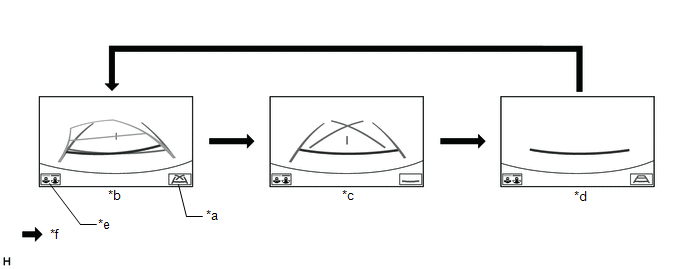
|
*a | Guide Line Display Mode Switching Button |
*b | Estimated Course Line Display Mode |
|
*c | Parking Assist Guide Line Display Mode |
*d | Distance Guide Line Display Mode |
|
*e | Display Mode Switching Button |
*f | Guide Line Display Mode Switching Button Pressed |
HINT:
The screen changes to the wide rear view screen when the display mode switching button is selected.
(1)
While the parking assist monitor is displayed on the multi-display,
pressing the guide line display mode switching button switches the
parking assist monitor display mode.
Parking Assist Monitor Display Mode |
Parking Assist Monitor Display Mode |
Distance Guide Lines (Red) |
Estimated Course Lines (Yellow) |
Distance Guide Line (Yellow) |
Vehicle Width Extension Guide Line (Blue) |
Distance Guide Line (Blue) |
Parking Assist Guide Lines (Blue) |
Vehicle Center Line (Blue) |
|
Estimated course line display mode |
Displayed | Displayed |
Displayed | Displayed |
Displayed | Not displayed |
Displayed |
| Parking assist guide line display mode |
Displayed | Not displayed |
Not displayed | Displayed |
Not displayed | Displayed |
Displayed |
| Distance guide line display mode |
Displayed | Not displayed |
Not displayed | Not displayed |
Not displayed | Not displayed |
Not displayed |
(b) Wide rear view screen
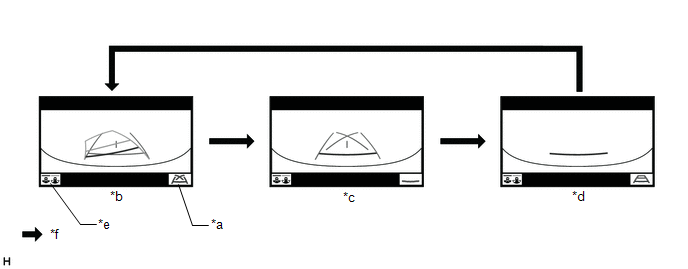
|
*a | Guide Line Display Mode Switching Button |
*b | Estimated Course Line Display Mode |
|
*c | Parking Assist Guide Line Display Mode |
*d | Distance Guide Line Display Mode |
|
*e | Display Mode Switching Button |
*f | Guide Line Display Mode Switching Button Pressed |
HINT:
The screen changes to the rear view screen when the display mode switching button is selected.
(1)
While the parking assist monitor is displayed on the multi-display,
pressing the guide line display mode switching button switches the
parking assist monitor display mode.
Parking Assist Monitor Display Mode |
Parking Assist Monitor Display Mode |
Distance Guide Lines (Red) |
Estimated Course Lines (Yellow) |
Distance Guide Line (Yellow) |
Vehicle Width Extension Guide Line (Blue) |
Distance Guide Line (Blue) |
Parking Assist Guide Lines (Blue) |
Vehicle Center Line (Blue) |
|
Estimated course line display mode |
Displayed | Displayed |
Displayed | Displayed |
Displayed | Not displayed |
Displayed |
| Parking assist guide line display mode |
Displayed | Not displayed |
Not displayed | Displayed |
Not displayed | Displayed |
Displayed |
| Distance guide line display mode |
Displayed | Not displayed |
Not displayed | Not displayed |
Not displayed | Not displayed |
Not displayed |
DIAGNOSTIC FUNCTION OUTLINE
(a)
This parking assist monitor system has a diagnostic function displayed
on the multi-display. This function enables calibration (adjustment and
verification) of the parking assist monitor system.
Click here

(b) The following items for the parking assist monitor system can be checked using the Techstream.
|
Item | Proceed to |
|
DTC |
 |
|
Data List / Active Test |
 |
System Diagram
SYSTEM DIAGRAM
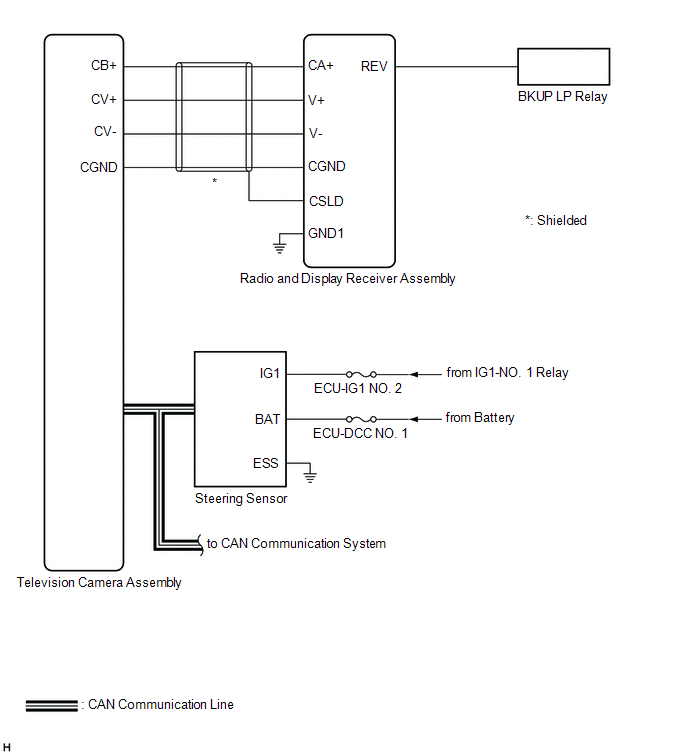
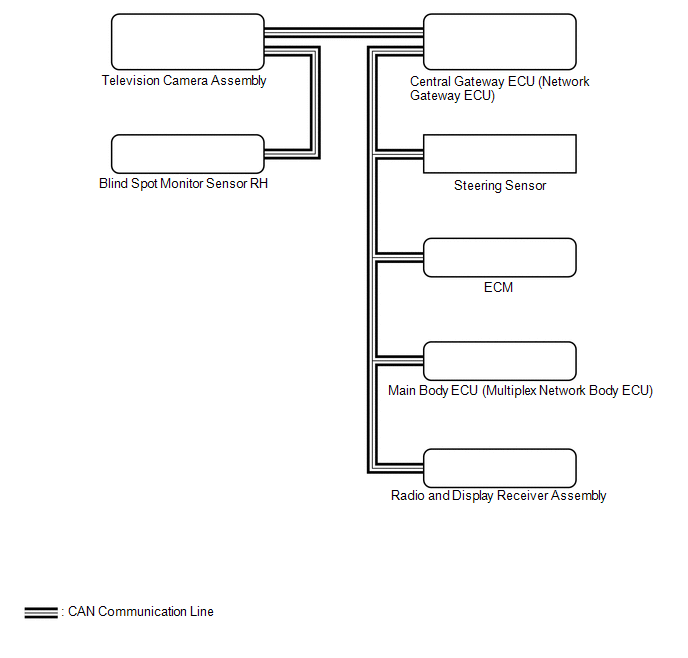 Communication Table
Communication Table |
Sender | Receiver |
Signal | Line |
|
Radio and Display Receiver Assembly |
Television Camera Assembly | Setting information signal |
CAN |
| Steering Sensor |
Television Camera Assembly |
Steering angle signal |
CAN |
| ECM |
Television Camera Assembly |
- Vehicle information signal
- Reverse signal
| CAN |
|
Main Body ECU (Multiplex Network Body ECU) |
Television Camera Assembly |
- Luggage compartment door courtesy switch signal
- Vehicle information signal
| CAN |
|
Blind Spot Monitor Sensor |
Television Camera Assembly |
RCTA information signal |
CAN |
Terminals Of Ecu
TERMINALS OF ECU
TELEVISION CAMERA ASSEMBLY
(a) Disconnect the P19 television camera assembly connector.

(b) Measure the voltage on the wire harness side connector according to the value(s) in the table below.
|
Terminal No. (Symbol) | Wiring Color |
Terminal Description | Condition |
Specified Condition |
|
P19-6 (CB+) - Body ground |
R - Body ground | Power source |
Engine switch on (ACC) |
5.5 to 7.05 V |
If the result is not as specified, there may be a malfunction on the wire harness side.
(c) Reconnect the P19 television camera assembly connector.
(d) Check for pulses between each terminal of the connector.
|
Terminal No. (Symbol) | Wiring Color |
Terminal Description | Condition |
Specified Condition |
|
P19-3 (CV+) - P19-2 (CV-) |
B - W | Video signal |
Engine switch on (IG) Shift lever in R Camera lens not covered, displaying image |
Pulse generation (Refer to waveform 1) |
|
Engine switch on (IG) Shift lever in R Camera lens covered, blacking out screen |
Pulse generation (Refer to waveform 2) |
|
P19-5 (CGND) - Body ground |
G - Body ground | Camera ground |
Always | Below 1 V |
HINT:
A
waterproof connector is used for the television camera assembly.
Therefore, inspect the waveform at the radio and display receiver
assembly with the connector connected.
If the result is not as specified, the television camera assembly may be malfunctioning.
(e) Reference (Oscilloscope waveform):
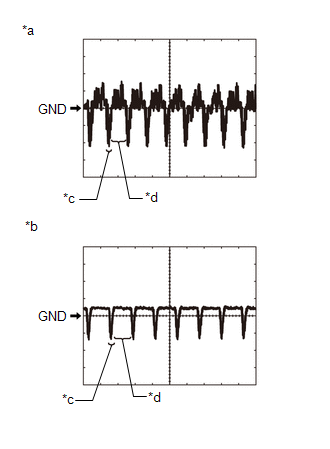
|
*a | Waveform 1 (camera lens is not covered, displaying an image) |
|
*b | Waveform 2 (camera lens is covered, blacking out the screen) |
|
*c | Synchronization Signal |
|
*d | Video Waveform |
HINT:
A
waterproof connector is used for the television camera assembly.
Therefore, inspect the waveform at the radio and display receiver
assembly with the connector connected.
(1) Waveform 1 (camera lens is not covered, displaying an image)
|
Item | Content |
|
Measurement terminal |
P19-3 (CV+) - P19-2 (CV-) |
|
Measurement setting | 200 mV/DIV., 50 ÎĽs./DIV. |
|
Condition | Engine switch on (IG), shift lever in R |
HINT:
- The video waveform changes according to the image sent by the television camera assembly.
- The video waveform is constantly output when the engine switch is on (ACC).
(2) Waveform 2 (camera lens is covered, blacking out the screen)
|
Item | Content |
|
Measurement terminal |
P19-3 (CV+) - P19-2 (CV-) |
|
Measurement setting | 200 mV/DIV., 50 ÎĽs./DIV. |
|
Condition | Engine switch on (IG), shift lever in R |
HINT:
- The video waveform changes according to the image sent by the television camera assembly.
- The video waveform is constantly output when the engine switch is on (ACC).
RADIO AND DISPLAY RECEIVER ASSEMBLY
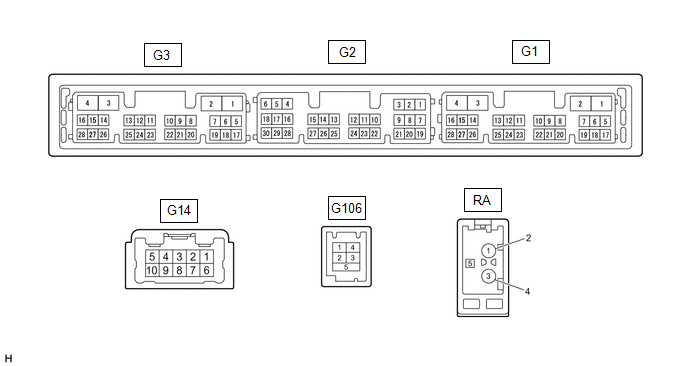
|
Terminal No. (Symbol) | Wiring Color |
Terminal Description | Condition |
Specified Condition |
|
G2-26 (CSLD) - Body ground |
Shield - Body ground |
Shield ground | Always |
Below 1 V |
|
G2-27 (CGND) - Body ground |
G - Body ground | Camera ground |
Always | Below 1 V |
|
G2-28 (V+) - G3-1 (GND1) |
B - BR | Video signal |
Engine switch on (IG) Shift lever in R Camera lens not covered, displaying image |
Pulse generation (Refer to waveform 1) |
|
Engine switch on (IG) Shift lever in R Camera lens covered, blacking out screen |
Pulse generation (Refer to waveform 2) |
|
G2-29 (V-) - G3-1 (GND1) |
W - BR | Ground |
Always | Below 1 V |
|
G2-30 (CA+) - G3-1 (GND1) |
R - BR | Television camera assembly power supply |
Engine switch on (ACC) |
5.5 to 7.05 V |
(a) Reference (Oscilloscope waveform):
(1) Waveform 1 (camera lens not covered, displaying an image)
|
Item | Content |
|
Measurement terminal |
G2-28 (V+) - G3-1 (GND1) |
|
Measurement setting | 200 mV/DIV., 50 ÎĽs/DIV. |
|
Condition | Engine switch on (IG), shift lever in R |
HINT:
- The video waveform changes according to the image sent by the television camera assembly.
- The video waveform is constantly output when the engine switch is on (ACC).

|
*a | Waveform 1 (camera lens is not covered, displaying an image) |
|
*b | Waveform 2 (camera lens is covered, blacking out the screen) |
|
*c | Synchronization Signal |
|
*d | Video Waveform |
(2) Waveform 2 (camera lens covered, blacking out the screen)
|
Item | Content |
|
Measurement terminal |
G2-28 (V+) - G3-1 (GND1) |
|
Measurement setting | 200 mV/DIV., 50 ÎĽs/DIV. |
|
Condition | Engine switch on (IG), shift lever in R |
HINT:
- The video waveform changes according to the image sent by the television camera assembly.
- The video waveform is constantly output when the engine switch is on (ACC).
Lost Communication with ECM / PCM "A" (U0100,U0126,U0140,U0163,U0233)
DESCRIPTION
These DTCs are stored if there is a malfunction in the CAN communication system connected to the television camera assembly.
HINT:
If CAN communication system DTCs are stored, they may also be stored in other systems.
|
DTC No. | Detection Item |
DTC Detection Condition | Trouble Area |
|
U0100 | Lost Communication with ECM / PCM "A" |
Lost Communication with ECM |
CAN communication system |
|
U0126 | Lost Communication with Steering Angle Sensor Module |
Lost communication with steering sensor |
CAN communication system |
|
U0140 | Lost Communication with Body Control Module |
Lost communication with main body ECU (multiplex network body ECU) |
CAN communication system |
|
U0163 | Lost Communication with Navigation Control Module |
Lost communication with radio and display receiver assembly |
CAN communication system |
|
U0233 | Lost Communication with Blind Spot Monitor Master Module |
Lost communication with blind spot monitor sensor RH |
CAN communication system |
PROCEDURE
(a) Clear the DTCs.
Chassis > Parking Assist Camera > Clear DTCs
(b) Recheck for DTCs and check that no DTCs are output.
Chassis > Parking Assist Camera > Trouble Codes
HINT:
- If CAN communication system DTCs are stored, they may also be stored in other systems.
- If the CAN communication system has been inspected and repaired in other
systems, the DTCs will not be output when rechecking for DTCs.
- If these DTCs are output frequently, duplicate the conditions that cause
the problem symptoms and perform the inspection again, even though the
DTC was not output when rechecking for DTCs.
Click here 
|
Result | Proceed to |
|
DTCs are output | A |
|
No DTCs are output | B |
| A |
 | GO TO CAN COMMUNICATION SYSTEM |
| B |
 | USE SIMULATION METHOD TO CHECK |
CAN Communication Failure (Message Registry) (U1000)
DESCRIPTION
This DTC is stored when the television camera assembly judges that it has an internal CAN malfunction.
|
DTC No. | Detection Item |
DTC Detection Condition | Trouble Area |
|
U1000 | CAN Communication Failure (Message Registry) |
Can communication failure (message registry) |
Television camera assembly |
PROCEDURE
(a) Clear the DTCs.
Chassis > Parking Assist Camera > Clear DTCs
(b) Recheck for DTCs and check that no DTCs are output.
Chassis > Parking Assist Camera > Trouble Codes
HINT:
- If the DTC is not output again when rechecking for DTCs, it may have been stored due to a temporary CAN malfunction.
- If DTC U1000 is stored frequently but is not output when rechecking for
DTCs, attempt to reproduce the conditions when the malfunction occurred.
Click here 
|
Result | Proceed to |
|
DTC U1000 is output | A |
|
DTC U1000 is not output |
B |
| A |
 | REPLACE TELEVISION CAMERA ASSEMBLY |
| B |
 | USE SIMULATION METHOD TO CHECK |




























































































































































































































































 Communication Table
Communication Table 








